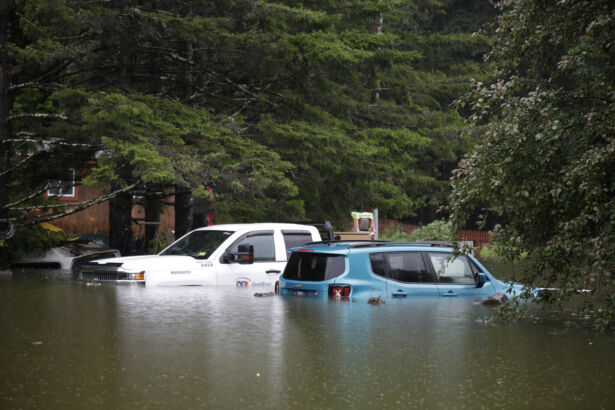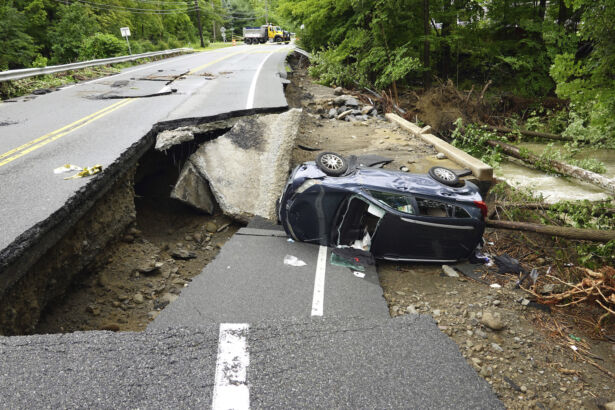President Joe Biden declared a state of emergency in Vermont on Tuesday after heavy rain drenched parts of the Northeast, triggering evacuations and causing tens of millions of dollars in damage.
Mr. Biden, currently at the annual NATO summit in Lithuania, has ordered the Federal Emergency Management Agency (FEMA) to help coordinate disaster relief efforts and provide assistance to areas affected by torrential downpours. The storm, which began on July 9, has dumped up to two months’ worth of rain in two days in Vermont and parts of the Northeast, including New York.
“Specifically, FEMA is authorized to identify, mobilize, and provide at its discretion, equipment and resources necessary to alleviate the impacts of the emergency,” the White House said in a statement on July 11. “Emergency protective measures, limited to direct Federal assistance and reimbursement for mass care, including evacuation and sheltering support, will be provided at 75 percent Federal funding.”
Gov. Phil Scott urged Vermonters at a news conference on Tuesday to remain cautious, saying severe flooding across the state is “nowhere near over,” and water levels continue to rise in some places, including in the state’s capital city, Montpelier.
“The good news is, the rain has stopped in some areas, but that does not mean waters will immediately recede. They may, in fact, continue to rise. And even though the sun may shine later today and tomorrow, we expect more rain later this week, which will have nowhere to go in the oversaturated ground,” Mr. Scott said.

“Although the comings days, weeks, and months will be incredibly difficult. We’ve faced challenges before, and Vermonters have risen to meet the moment. Whether during Irene, COVID, or other hardships, Vermonters have proven time and time again we’re willing and able to step up and help our neighbors,” he added.
The governor was referring to Tropical Storm Irene in August 2011. That storm killed six in the state, washed homes off their foundations, and damaged or destroyed more than 200 bridges and 500 miles of highway.
There have been no reports of injuries or deaths related to the flooding as of Tuesday morning, the Vermont Emergency Management said. The agency said five rescue teams have come to the state from North Carolina, Massachusetts, and Connecticut to assist with life-saving efforts.
Concerns Mount About Dam Nearing Capacity
In Montpelier, city officials announced in a statement that the downtown area will be closed until at least midday on Tuesday while the river that runs through the capital city recedes.
“This will allow officials to assess safety risks and begin clean up efforts. We know that business owners will be anxious to check out their stores but we urge patience,” officials said, adding damage is “unlikely to get worse” between 8 a.m. and noon as water levels drop.
Meanwhile, officials warned the Wrightsville Dam in Washington County’s Winooski River could exceed capacity for the first time should more water pour over, pointing out water could surge through downtown blocks where the floods are already waist-high.
The Montpelier Police Department said in a statement that authorities are continuing to monitor the water level, and as of midday on Tuesday, there has been no significant change. “We will continue to monitor the dam throughout the night,” police said.
New York
Vermont was not the only state hit hard by the storm. A flood watch also remains in effect for parts of New York, where a woman identified by police as Pamela Nugent, 43, died as she tried to escape her flooded home with her dog in the hamlet of Fort Montgomery.
“Her fiancé literally saw her swept away,” New York Gov. Kathy Hochul said during a news conference on a muddy street in Highland Falls, just south of the academy on the west bank of the Hudson River.
The U.S. Military Academy at West Point was pounded with more than 8 inches of rain that sent debris sliding onto some roads and washed others out.

“Nine inches of rain in this community,” Ms. Hochul said. “They’re calling this a ‘1,000-year event.'”
Meanwhile, more than 1,200 flights to and from airports, including New York’s LaGuardia and Boston’s Logan, were delayed or canceled on July 10 as severe flash flooding hit the East Coast. The July 10 flight disruptions follow more than 8,000 delays on July 9 and more than 2,000 cancellations, Travel + Leisure reported.
The Associated Press contributed to this report.
